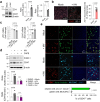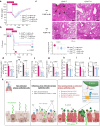Airway epithelial CD47 plays a critical role in inducing influenza virus-mediated bacterial super-infection
- PMID: 38693120
- PMCID: PMC11063069
- DOI: 10.1038/s41467-024-47963-5
Airway epithelial CD47 plays a critical role in inducing influenza virus-mediated bacterial super-infection
Abstract
Respiratory viral infection increases host susceptibility to secondary bacterial infections, yet the precise dynamics within airway epithelia remain elusive. Here, we elucidate the pivotal role of CD47 in the airway epithelium during bacterial super-infection. We demonstrated that upon influenza virus infection, CD47 expression was upregulated and localized on the apical surface of ciliated cells within primary human nasal or bronchial epithelial cells. This induced CD47 exposure provided attachment sites for Staphylococcus aureus, thereby compromising the epithelial barrier integrity. Through bacterial adhesion assays and in vitro pull-down assays, we identified fibronectin-binding proteins (FnBP) of S. aureus as a key component that binds to CD47. Furthermore, we found that ciliated cell-specific CD47 deficiency or neutralizing antibody-mediated CD47 inactivation enhanced in vivo survival rates. These findings suggest that interfering with the interaction between airway epithelial CD47 and pathogenic bacterial FnBP holds promise for alleviating the adverse effects of super-infection.
© 2024. The Author(s).
Conflict of interest statement
The authors declare no competing interests.
Figures






References
Publication types
MeSH terms
Substances
Grants and funding
- 2019M3A9B6066971/National Research Foundation of Korea (NRF)
- 2016M3A9D5A01952415/National Research Foundation of Korea (NRF)
- 2013M3A9D5072550/National Research Foundation of Korea (NRF)
- 2021M3H9A1030260/National Research Foundation of Korea (NRF)
- RS-2023-00250400/National Research Foundation of Korea (NRF)
LinkOut - more resources
Full Text Sources
Medical
Molecular Biology Databases
Research Materials

